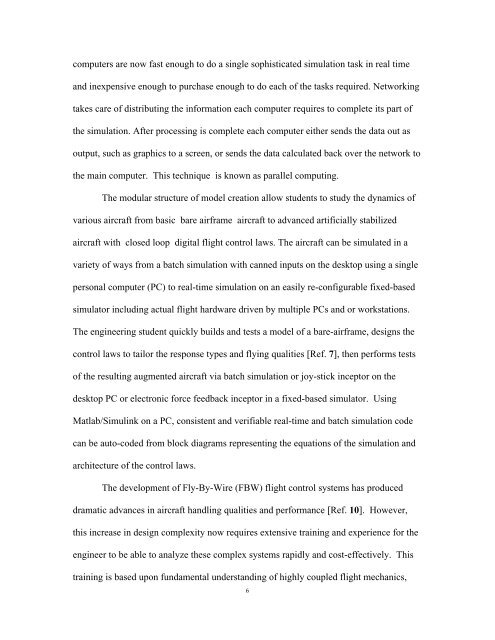- Page 2: Authorization PageI grant permissio
- Page 6 and 7: Table of ContentsLIST OF TABLESXIIL
- Page 8 and 9: Standard Atmosphere 64Input 65Outpu
- Page 10 and 11: RK4 (RUNGE-KUTTA) HELP FILE 91RK4 (
- Page 12 and 13: List of TablesTablePageTable 1. Air
- Page 14 and 15: Figure 27. Kaman SH2-F 72Figure 28.
- Page 16 and 17: has been developing a set of the ba
- Page 18 and 19: Simulink is a graphical user interf
- Page 22 and 23: simulation after the conversion. Th
- Page 24 and 25: then a simple one axis closed loop
- Page 26 and 27: PhEagle IPhEagle Hardware - Sim Cab
- Page 28 and 29: highlight some text on a word proce
- Page 30 and 31: up to perform the less processor in
- Page 32 and 33: the Heads Up Display (HUD). While c
- Page 34 and 35: and monitors and computer code to s
- Page 36 and 37: Existing Simulation ToolsThere are
- Page 38 and 39: great control over the model dynami
- Page 40 and 41: Figure 11 BYOFS Original ScreenFigu
- Page 42 and 43: Basic 6-DOF Nonlinear, Rigid Body,
- Page 44 and 45: 0 18 Cmu - Pitch moment due to forw
- Page 46 and 47: each of the linear force terms. The
- Page 48 and 49: PhEagle IIPhEagle II Introduction a
- Page 50 and 51: instructor a graphical interface to
- Page 52 and 53: Simulink block set, however, when m
- Page 54 and 55: existing graphics by creating a TCP
- Page 56 and 57: Simulink environment, and Mathworks
- Page 58 and 59: D/A (output) block is the code for
- Page 60 and 61: Table 9 Cab InputsInput from cab ou
- Page 62 and 63: Key Features of SimulationsStabilit
- Page 64 and 65: subsystem with inputs and outputs.
- Page 66 and 67: viewer has the end of the runway co
- Page 68 and 69: The 6 degree of freedom (3 translat
- Page 70 and 71:
difference between the two axes are
- Page 72 and 73:
Unit Delay1zelevatorelevElevElevato
- Page 74 and 75:
6 DOF Model VerificationThe 6 DOF m
- Page 76 and 77:
oth models. The two state space mod
- Page 78 and 79:
Impulse ResponseRoll Angle32.5Ampli
- Page 80 and 81:
modeled. By feeding back any of the
- Page 82 and 83:
R10000 processors an inceptor Flybo
- Page 84 and 85:
directly to the Euler block the out
- Page 86 and 87:
function and the dynamics were very
- Page 88 and 89:
made by handling qualities engineer
- Page 90 and 91:
mode. The aircraft was divergent de
- Page 92 and 93:
simplified to resemble a spring-dam
- Page 94 and 95:
the data and converting to the prop
- Page 96 and 97:
ConclusionsConverting existing soft
- Page 98 and 99:
Future WorkPhEagle II provides basi
- Page 100 and 101:
workstation or PC for function test
- Page 102 and 103:
13. Tischler, M. B.; Chen, R. T. N;
- Page 104 and 105:
AppendixEuler Help File%***** euler
- Page 106 and 107:
k4=dt*(z(index-1)+l3/2.0);l4=dt*(-a
- Page 108 and 109:
float K = 10.0;printf("\nEnter wn [
- Page 110 and 111:
Snoopy 2nd order RK4 Class//-------
- Page 112 and 113:
{private:void CalcPowerDyn();void C
- Page 114 and 115:
int opMode;int oldVmode;int checkpt
- Page 116 and 117:
}exit_code = 0;}if (opMode != DEBUG
- Page 118 and 119:
}opMode = HELP;else if ((*argv[i] =
- Page 120 and 121:
Instrument D/A Simulink S-function/
- Page 122 and 123:
* Function: mdlInitializeSampleTime
- Page 124 and 125:
cdVerIndicator.channelNumber=5;cdVe
- Page 126 and 127:
set(&yawForceOut,*uPtrs[26]);set(&r
- Page 128 and 129:
Instrument Help Filefunctionallinst
- Page 130 and 131:
Stick D/A Simulink S-function/*****
- Page 132 and 133:
aToD12.cntCtrl=addr + 3;aToD12.da1L
- Page 134 and 135:
* with in an enabled subsystem whic
- Page 136 and 137:
#define MDL_DERIVATIVES /* Change t
- Page 138 and 139:
Abbreviated Instrument D/A Simulink
- Page 140 and 141:
{d16.nBits=16;d16.baseAddr=0x340;d1
- Page 142 and 143:
InputRealPtrsType uPtrs = ssGetInpu
- Page 144 and 145:
#ifdef MATLAB_MEX_FILE /* Is this f
- Page 146 and 147:
Abbreviated Stick D/A Simulink S-fu
- Page 148 and 149:
aToD12.da2Low=addr + 6;aToD12.da2Hi
- Page 150 and 151:
*/static void mdlDerivatives(SimStr
- Page 152 and 153:
Header file for Stick S-functions//
- Page 154 and 155:
Abbreviated Stick Help filefunction
- Page 156 and 157:
#define Deg2Rad 0.01745329#define R
- Page 158 and 159:
* Parameter Value Description* Name
- Page 160 and 161:
* y[15]= qDot* y[16]= rDot* y[17]=
- Page 162 and 163:
***** Compute the rolling moment ex
- Page 164 and 165:
xDot=u*CTheta*CPsi+v*(SPhi*STheta*C
- Page 166 and 167:
SAD file: Navion.tsf2.153 1 Alt1 [f
- Page 168 and 169:
% | sAcB -sAsB cA | Fzb% Test dataF
- Page 170 and 171:
Standard Atmosphere Simulink S-func
- Page 172 and 173:
* in estimate();** Alt=*uPtrs[0]; m
- Page 174 and 175:
Euler Coordinate Transform and Inte
- Page 176 and 177:
* Abstract:* Specifiy that we inher
- Page 178 and 179:
* calulate the trig functions first
- Page 180 and 181:
Euler Transform Help Filefunction [
- Page 182 and 183:
Game Joystick Driver Simulink S-fun
- Page 184 and 185:
*/static void mdlInitializeConditio
- Page 186 and 187:
* This function is called once for
- Page 188 and 189:
Navion Longitudianal State Space Se
- Page 190 and 191:
ANavionLatB=[0 .07045610 028.73202
- Page 192 and 193:
Navion Longitudinal State Space Set
- Page 194 and 195:
NNavionLatB=[0 0.070456128.73202 2.
- Page 196:
% create a frequency vectorw=0.1:0.













